We can design and produce customized objects from recycled polyethylen tereftalate. We use the technology of 3D printing in order to deliver limited series of beautiful, useful and precise objects on request.
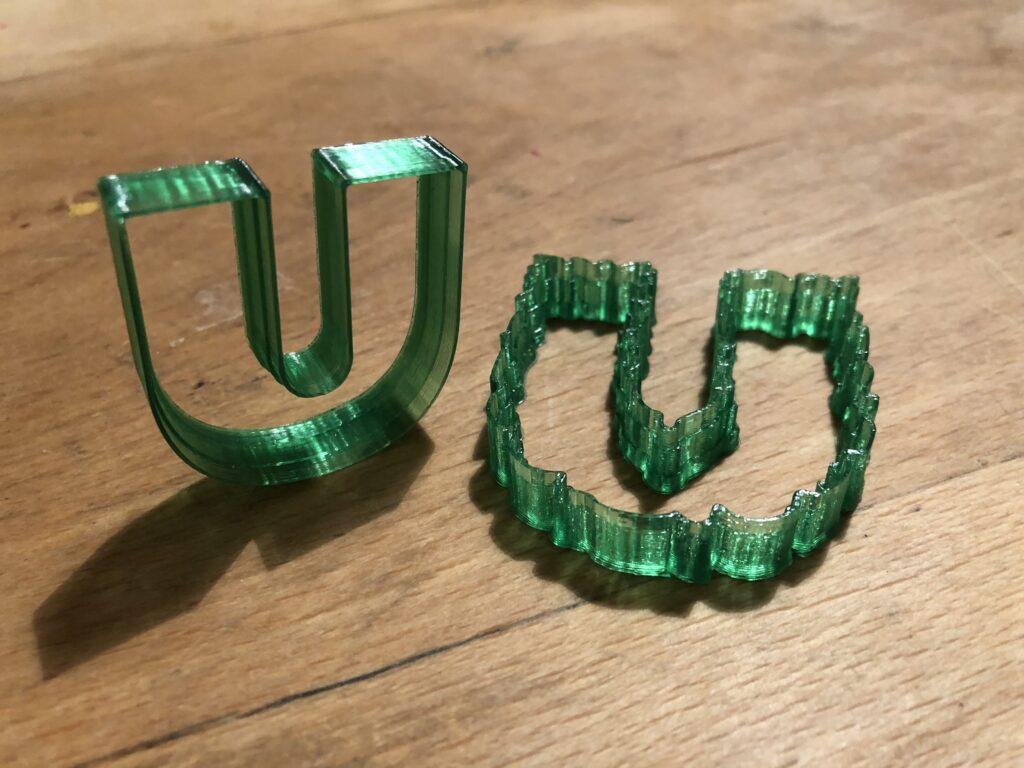
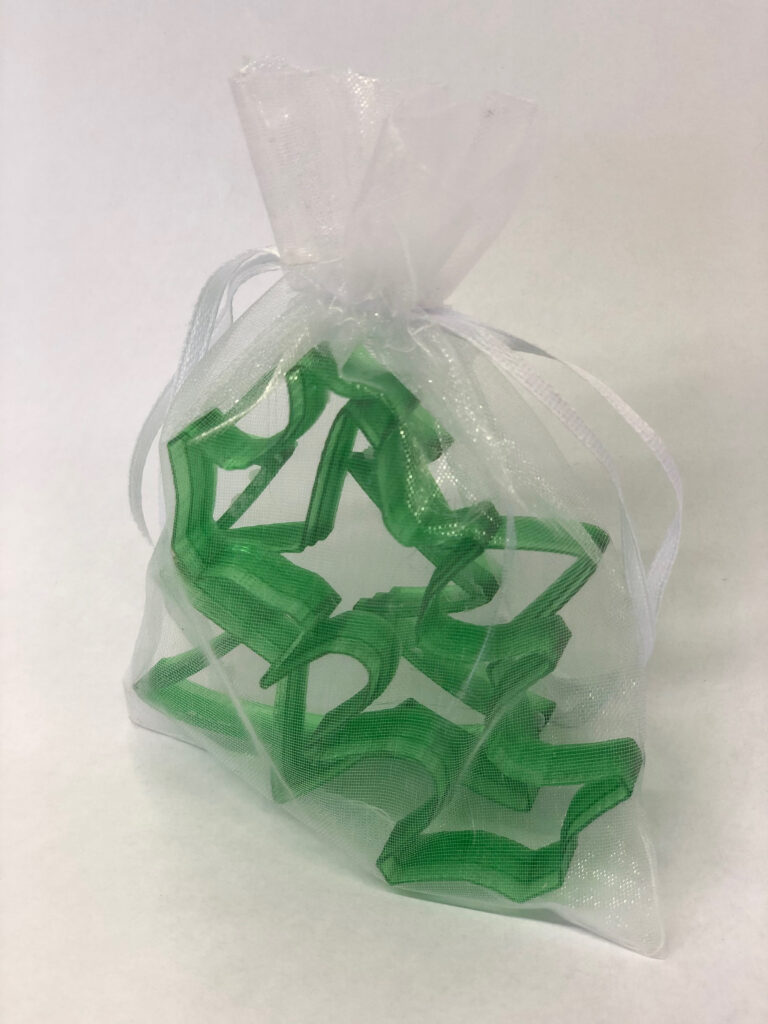
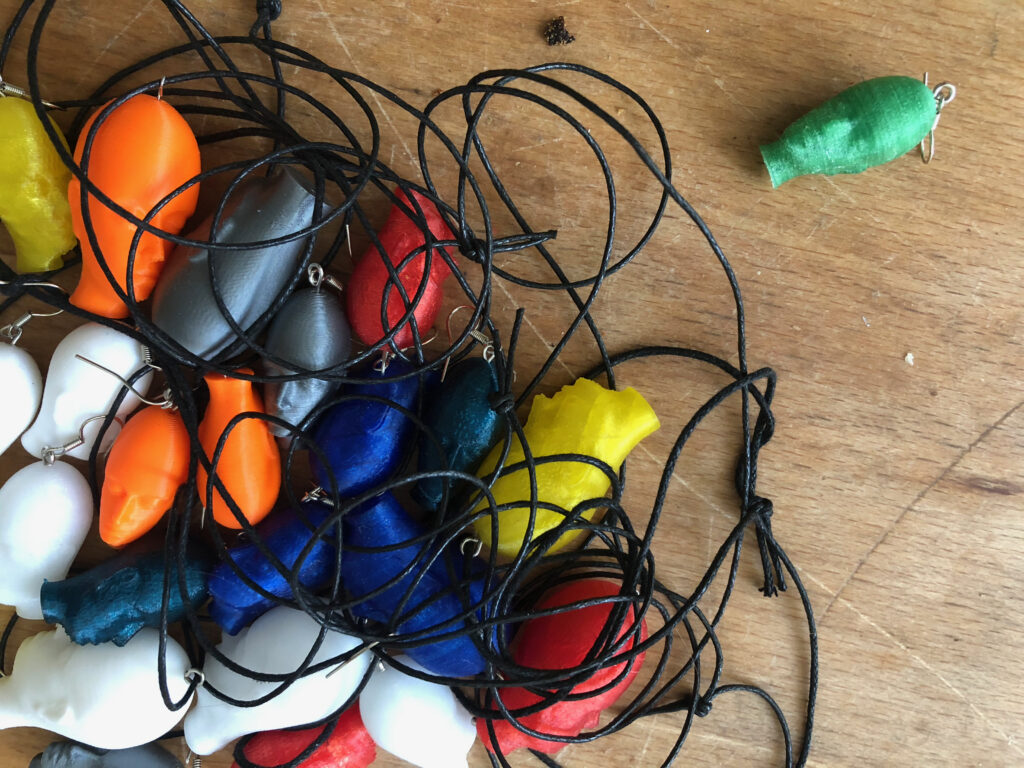
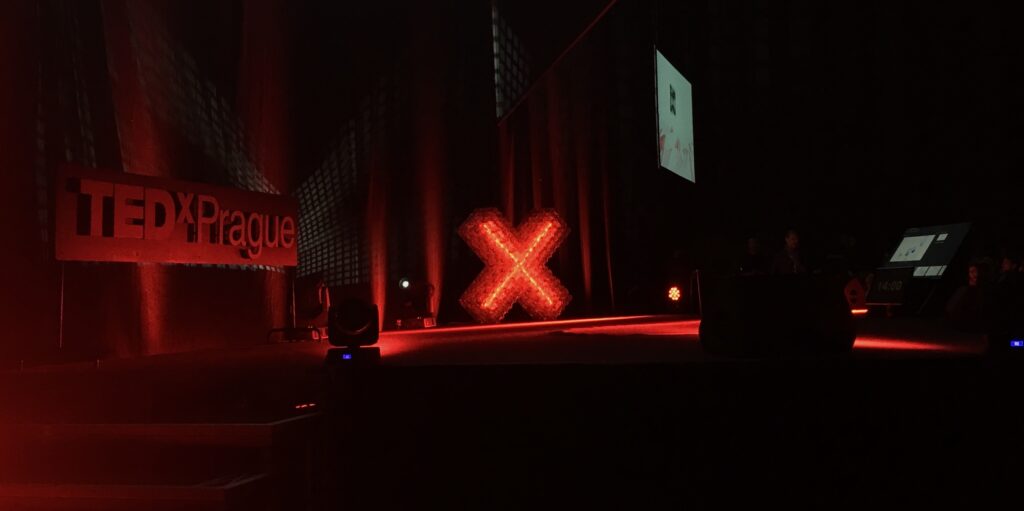
A thirteen-meters high Christmas Tree placed in the town square in Kaunas was assembled from 32 000 PET bottles attached together with cable ties. The author is an artist Jolanta Smidtienė, who is dealing with the christmas decorations of the town for longer time want to create something different each year.
The energy saved for the material was used for the lighting of the tree, where 40 000 light bulbs were installed. Nevertheless, the message of the artificial Christmas tree is obvious: Let’s think about ecology and our own consumption at least during the Christmas time!
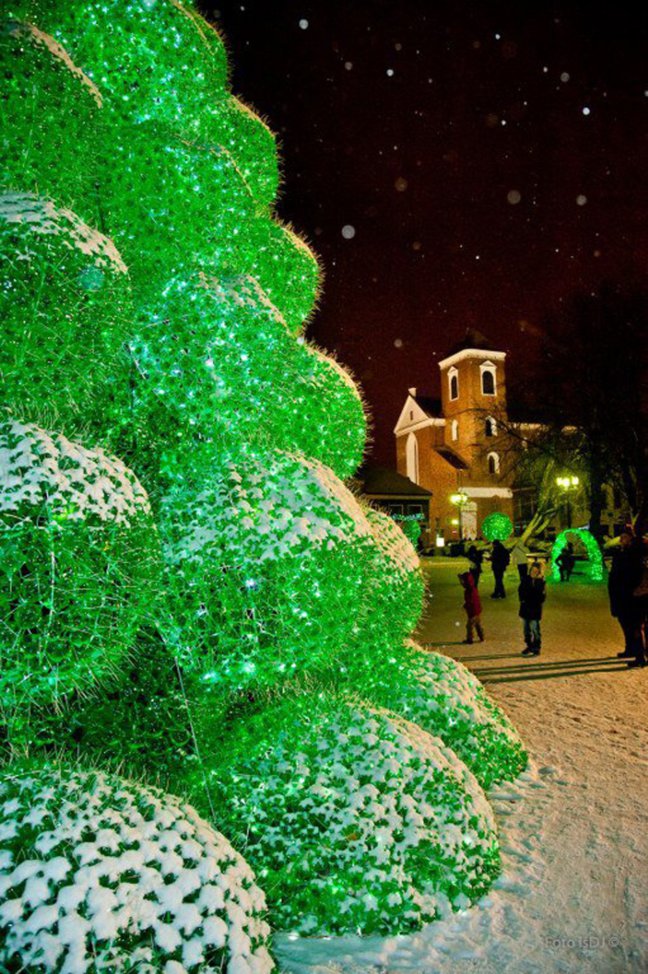
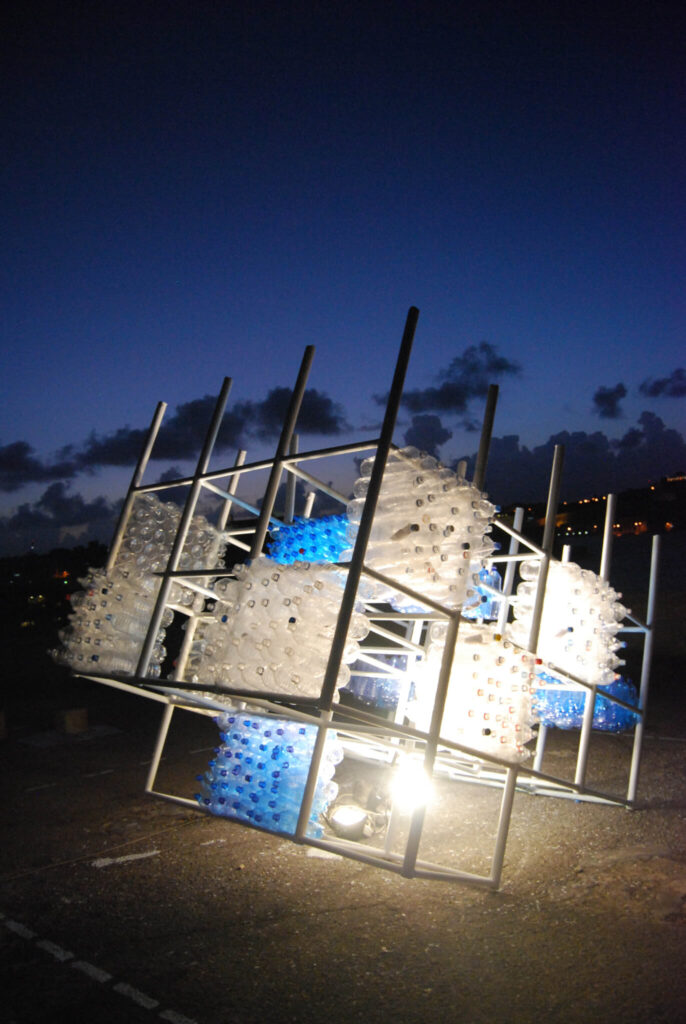
The project was done for an annual 3 day SACES workshop organised by the Society of Architecture and Civil Engineering Students at the University of Malta. Building something out of waste material was the most instinctive thing to do.
Which we did, but we also wanted to encapsulate an other intangible waste; The waste of ideas from self-inhibition (shame, shyness, distrust)
Used plastic bottles were utilized as a way to contain and store ideas written down on paper; using the concept of the message in a bottle.
On the site of the workshop we found a discarded steel frame previously used as “Monkey bars” in an abandoned playground.
We found this steelframe to be ideal to hold these thoughts and ideas together as one monumental body. Furthermore these ‘monkey bars’ reminds in the act of play, an action were self-inhibition is pushed aside for creativity and individualism to get loose.
The project was used as an interactive sculpture where visitors would go around/below/inside the steel frame, choose their desired bottle and white down whatever thought they feel like to go out in the open. Approximately 480 bottles were used. The translucency of the material made it possible to be used at night as a lantern, attracting more visitors during the night.
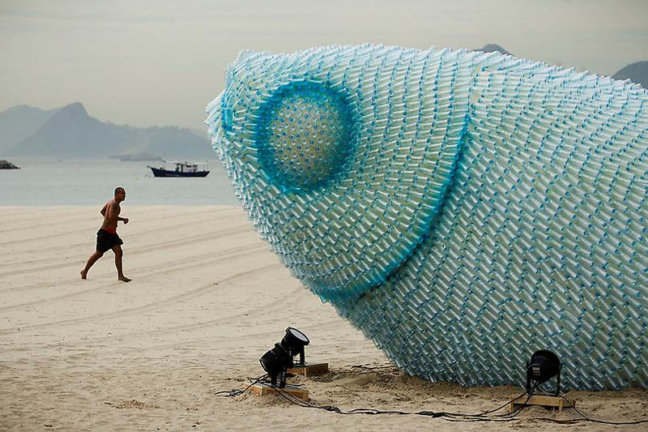
Three giant fish made out of PET bottles was an installation that was part of a United Nations Conference on Sustainable Development. The three fish were created under the slogan “recycle your attitude” and should resemble a family. The sculptures can be lit at night in various colors.
The floating geodesic dome Rising Moon was designed for the autumn festival “lantern wonderland” 2013 in Victoria Park in Hong Kong by the local architecture firm named Daydreamers. The dome has a 20 meter diameter, and for the surface covering 4800 five gallon (22,7 liter) polycarbonate water containers were used. These containers were mounted into a network of electric sockets with LED lighting. The sphere’s surface was triangulated – each triangle carried about 28 water containers. The main structure is a steel rod frame.
The bottles were chosen for their resemblance with traditional Chinese beacon-shaped lanterns. In the interior of the dome 2300 regular PET bottles are suspended from the ceiling providing the effect of the sea. Since the pavilion is floating, the whole appears to be a complete sphere because of the reflection of the water. By manipulating the LED lights, multiple phases of the moon can be simulated on the surface – hence the name of the pavilion. Additionally in the top of the pavilion there is an opening in the roof which allows the real moonlight pass through the pavilion. According to Daydreamers architects, the whole building can be de-assembled and the parts (bottles) recycled.
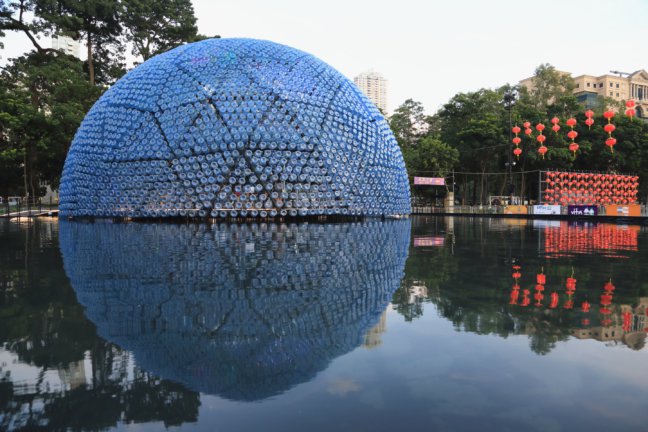

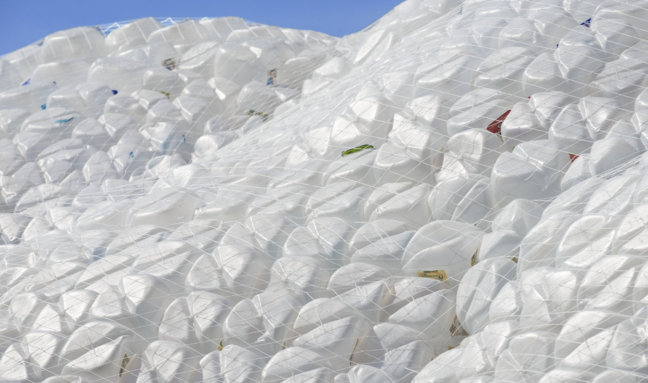

Head in the clouds is a pavilion built on the occasion of figment’s 2013 ‘city of dreams art celebration’ in New York. The sculpture was assembled by Jason Klimoski and Wesley Chang from KCA architects, who needed 53,780 recycled plastic bottles and milk containers – this amount is consumed in NYC in about 1 hour.
While the milk jugs form the exterior cloud visually, the interior is created from smaller 16 and 24 ounce PET bottles filled with blue colour water evocating the feeling of being in the middle of a cloud. This all is held up with an aluminium frame. The structure can shelter approximately 50 people. The installation ran for approximately 2 months from february 2013.
The Coca Cola Bow created by Studio Penda is an example of advertising and recycling combined. It was designed and built at the occasion of the 2nd Beijng University Creation Expo. The bow is a rigid structure of which the surface is covered with a chicken wire pattern. The maze opening of the chicken wire has the exact right dimension so that a PET bottle can be screwed into it. The bottles needed for the object were collected in cooperation with Coca Cola and universities around Beijng; for every 10 empty Coca Cola bottles handed in one free Cola Cola bottle was rewarded.
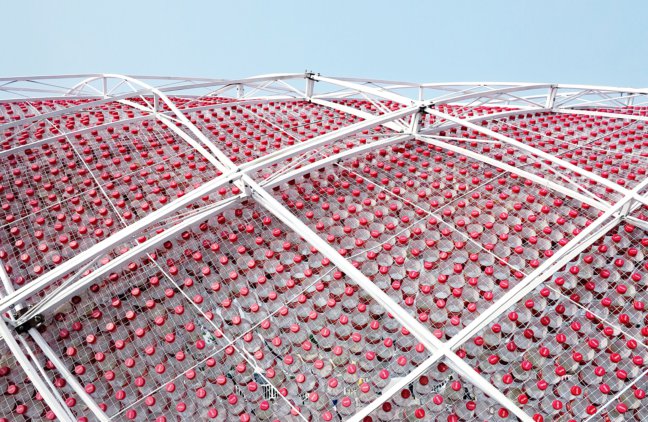
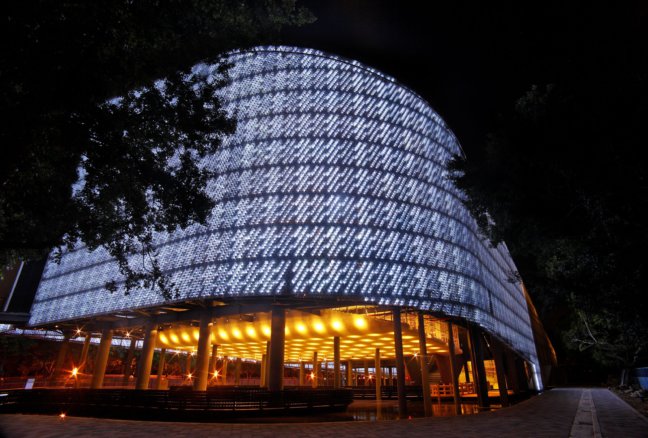
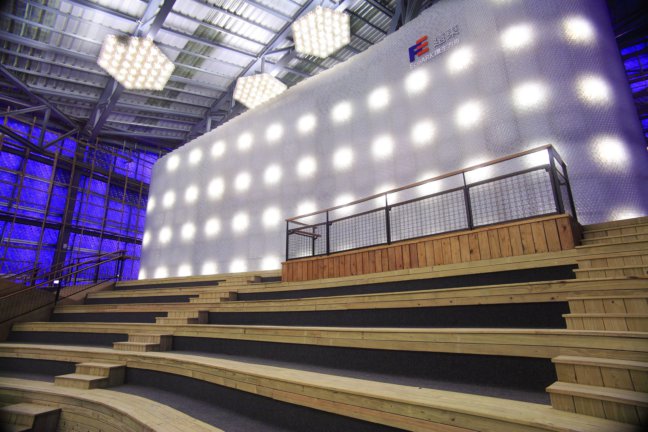
The project was done for an annual 3 day SACES workshop organised by the Society of Architecture and Civil Engineering Students at the University of Malta. Building something out of waste material was the most instinctive thing to do.
Which we did, but we also wanted to encapsulate an other intangible waste; The waste of ideas from self-inhibition (shame, shyness, distrust). Used plastic bottles were utilized as a way to contain and store ideas written down on paper; using the concept of the message in a bottle.
On the site of the workshop we found a discarded steel frame previously used as “Monkey bars” in an abandoned playground. We found this steelframe to be ideal to hold these thoughts and ideas together as one monumental body. Furthermore these ‘monkey bars’ reminds in the act of play, an action were self-inhibition is pushed aside for creativity and individualism to get loose.
The project was used as an interactive sculpture where visitors would go around/below/inside the steel frame, choose their desired bottle and white down whatever thought they feel like to go out in the open. Approximately 480 bottles were used. The translucency of the material made it possible to be used at night as a lantern, attracting more visitors during the night.
The project of United Bottle was developed by Dirk Hebel, Tobias Klauser and Jörg Stollmann. It is a PET water bottle and a building unit at the same time, which can be normally recycled. It can be distributed in six-packs on containers and collected in plastic waste containers. This makes the bottle suitable for application in catastrophy-hit regions where both drinking water and building material are scarce and in need.
The bottle can be used repeatedly for water storage, but there is also a second use: it can be filled with heavy material such as sand and dirt, and then used as a brick. It can also be left empty and used as a building element for a light-weight structure such as an indoor pavilion.
The concept of United Bottle is intended to solve both the garbage problem and the housing need for areas destroyed by hurricane or tsunami. The bottles can be used to build stable walls for temporary and long term shelter – these structures can be covered by tents or other membrane structures. The pieces lock into each other which gives additional stability and resistance to torsion. In 2007 the first prototype of the United Bottle was 3D printed by stereolithography.
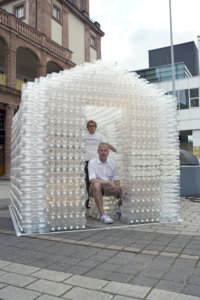
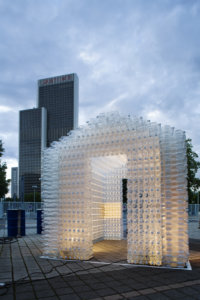
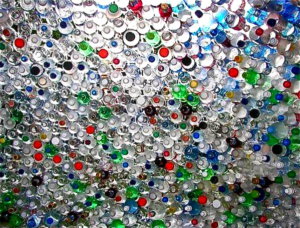
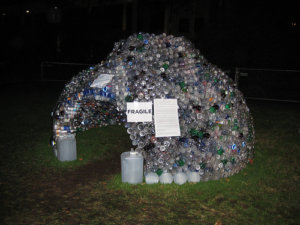
Jasmine Zimmerman created an open-roofed spherical house which measures 12 x 12 x 6 feet (3.6 x 3.6 x 1.8 meter) created out of thousands of PET bottles. With this structure she wanted to point out the fact that Americans waste over 30 billion of PET bottles a year, only 10% of which are recycled.
The structure is created by glueing PET bottles together with hot glue pistol (which by the way renders the bottles unrecyclable in any normal fashion). As an object for raising awareness it can be considered successful however, because she made two installations at festivals (Bumbershoot and City Sol Festival in New York) where people themselves actually added their disposable PET bottles to the structure. In that way the structure grew in an almost organic fashion and people were more directly confronted with the waste issue.
The Trash temple is constructed out of a number of blocks which are actually pressed bales of millions of PET bottles. The temple was designed by Salzig Design. The structure won second prize at the International Ideas Competition at Folly Dock 2007.
The temple was seven meters high, 10 meters wide, and has a circumference of about 25 meters. Visitors could climb up to the top and also enter the structure on ground level. The idea was that in this place where they could perceive the smell of the garbage they would understand the uselessness of overproduction. The structure was surrounded by thousands of sunflowers that marked the footpaths and added symmetry to the place of contemplation.
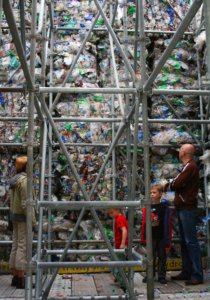
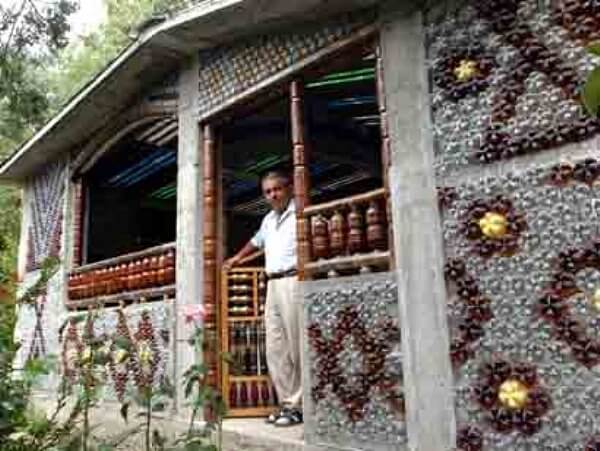
A house made of 13,500 plastic bottles was built by a retired proffesor of mathematics Tomislav Radovanovič. Only the foundation is made of concrete. With the help of his students, compeltion of this house took the builder 5 years. Not only the floor, the walls and the columns and the roof is made of plastics, the house is also equipped with articles made of PET bottles. The kitchen table and the chairs, the lights and even the bathroom was designed from plastics. Some bottles are filled with concrete. some with silicon and the rest is left empty. The shape of the bottles is changed in some cases with the use of heat and wooden or steel mould. Some decorative pieces were painted by the author. Additionally 2500 caps were used just for decoration.
(POP)Culture shelter is a project by Garth Britzmann who intended to create a canopy shading device above a parking lot. 1581 empty soda bottles of 20oz (0.6 liters) were filled with a small amount of colored water. The basic structure of the canopy is a frame structure. The bottles are attached by strings. It took 27 volunteers 12,5 days to connect the bottles to the strings and erect the final construction. The object stood on site for three months. It was demolished because it was discovered that mold had formed in the bottles.
The projects’ geometry was created with the use of 3D modelling software Rhinoceros with scripting in Grasshopper plug-in for this program. First the surface was designed, and after that the length of the strings was derived, and also the color of the water for the bottles, which was related to the height from the plane.
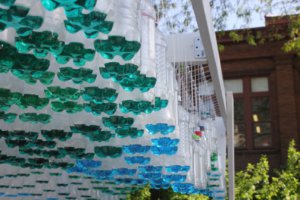
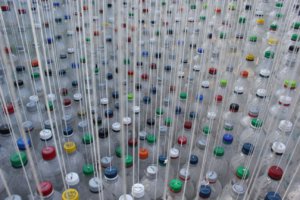
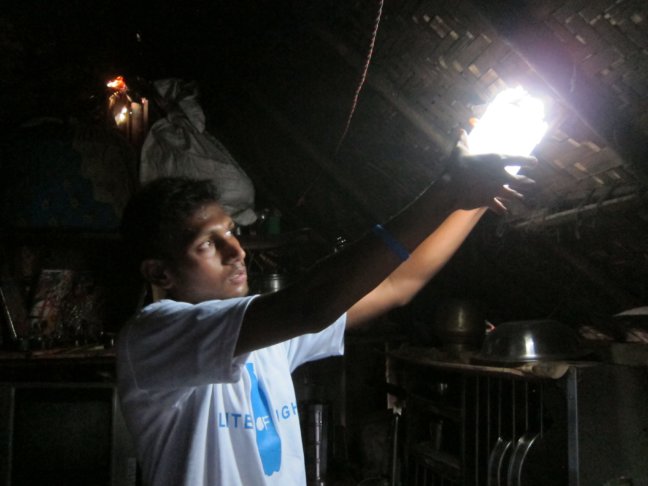
Well known for his global change activities Illacs latest project introduces zero cost lighting method using plastic bottle filled with water. The bottle is mounted into the roof of a dark shed where it is able to transmit sunlight in order to enlight the interior. The example comes from Malabon Metro Manila in the Phillippines
The South African designer Heath Nash took part in the HIFA performing arts festival in Harare, Zimbabwe, 2011, where he created in cooperation with local craftsmen shading structures made out of found and dumped material and PET bottles. The shading on the image to the left shows a triangular construction made of steel perforated L-profiles. Wires are spanned between the profiles and on these wire the blue PET bottles are fastened. The bottles are empty and therefore very light, thus the wires are sufficient to hold the structure.
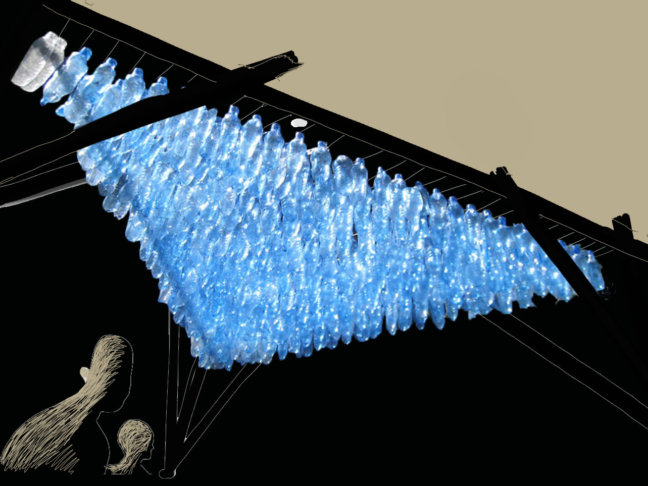
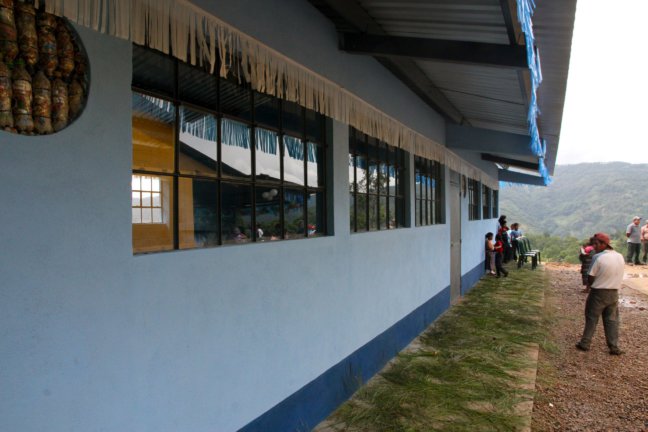
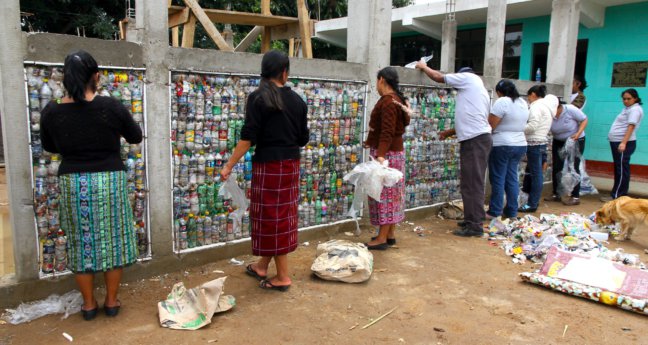
In Guatemala a technique is used which was invented by Susanne Heisse. Plastic bottles are filled with plastic garbage found on the streets: plastic bags, wrappings, pieces of styrofoam, and so on. The bottles remain light and obtain a slightly higher isolation value. For the construction of the building it is necessary to construct a simple frame, either of wood or concrete. The bottles are fixed within the frame between two layers of chicken wire fencing. The wall is then covered and stiffened with cement mortar.
Because of the climate conditions there is no need for very high isolation values. The bottles are only used as filling to reduce the amount of cement that is necessary to make the walls. There also plays the role empowerment: the school children and people of the neighborhood are involved in the construction of their own school which is possible because the technology is very straightforward and does not involve trained labour. Finally, the participants learn from this how to build structures from on-site resources and garbage.
Case del Fe (Faith House) is a house built for the Hondurian Foundation for Rehabilitation and integration of handicapped people. This building does not feature a green roof. For pillars, Andreas Froese used vehicle wheel rims to create columns.
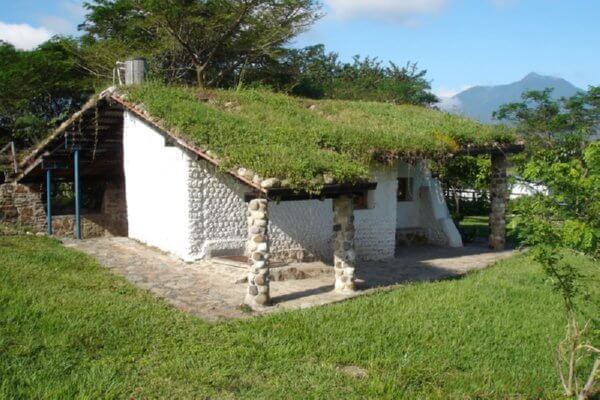
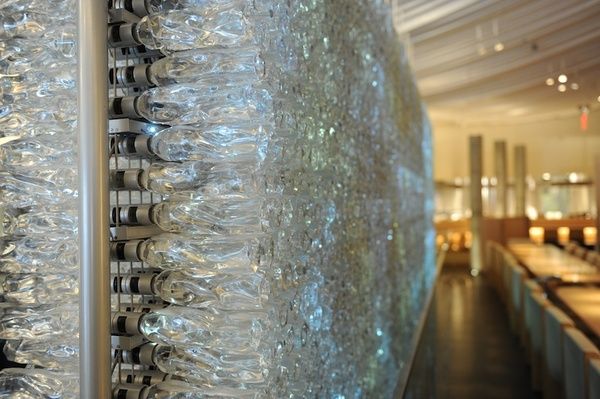
The Japanese architect Tadao Ando designed a spectacular wall incorporating 17 400 PET bottles of 0,5 liter for the interior of the Morimoto restaurant in New York City. The bottles are filled with mineral water. The bottles are mounted horizontally on a frame by means of couplers. There are also LED lights at the couplers so that in this way the wall becomes a lighting element in the restaurant. The electricity is led horizontally on a bracing. The wall is two floors high.
TrussFab is an integrated end-to-end system that allows users to fabricate large scale structures that are sturdy enough to carry human weight. TrussFab achieves the large scale by complementing 3D print with plastic bottles.
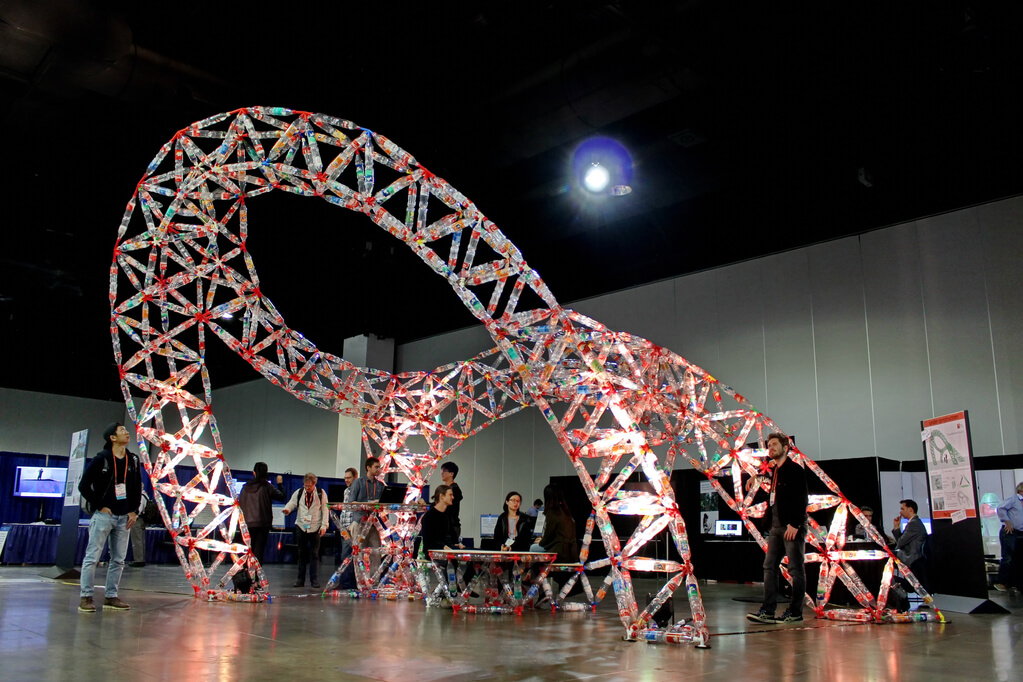

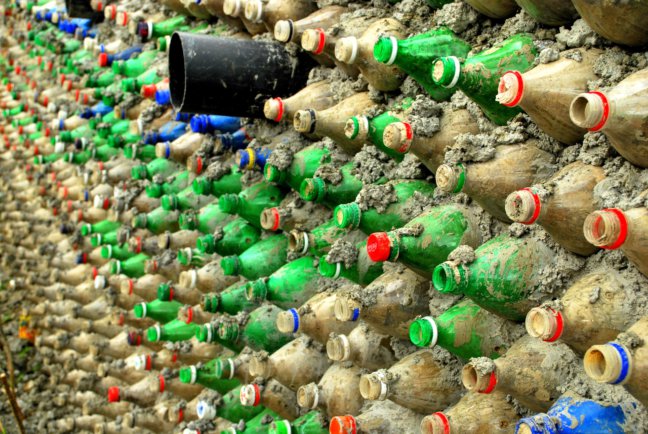
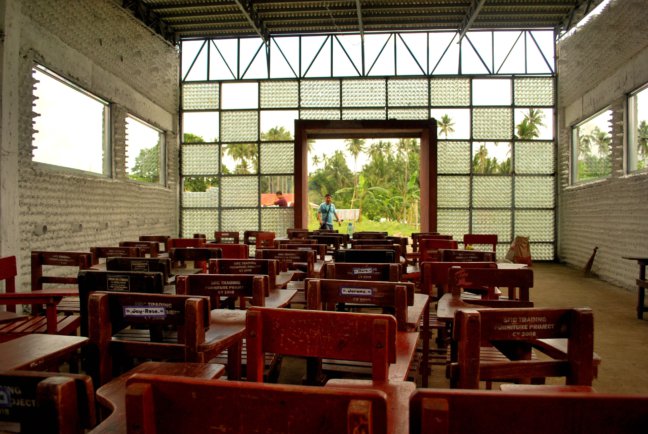
The My Shelter foundation (led by Illac Angelo Diaz) acquired site from the local government in San Pablo and sponsorship by Pepsi to build their first PET bottle school in Asia on the Philippines. For the school construction, 9000 PET bottles were collected during a public run in San Pablo and filled with mud, sand, straws, and even manure, all of this mixed with water. The space between the bottles is also filled with adobe which later simply dries in the sun. The structure is strenghtened by steel bars.
There exist several examples of such schools, most often realized by non-governmental organisations, such as My Shelter and Hug it Forward. Building the object is usually just visible result of primar intentions: community support together with cleaner landscape. The latter has already built a number of schools in Guatemala. The precursor of Hug it Forward is the independent organization Pura-vida founded by Susana Heisse in 2005.
This ECO activist and former East German prisoner founded the Pura Vida organization in order to help people in solving the garbage problem in the village of San Marcos. Two years later it moved to Lake Atitlan to form an Ecological movement: Susana Heisse invented the technology of ECO-brick: a PET bottle stuffed with oter plastic garbage. The ECO-brick is light, insulating and sustainable building unit using only local resources. When cleaned and closed its hygienic and shows safer behaviour during earthquakes.
After a hurricane Stan in 2005 Susana Heisse realized garbage could be turned into cheap building material. In 2008 Pura Vida developed their first Alternative Recycle Manual (www.puravidaatitlan.org), where communities around the world can learn how to transform garbage into construction.
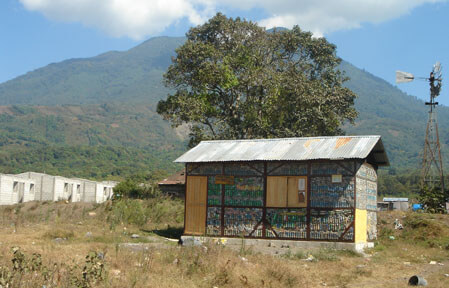
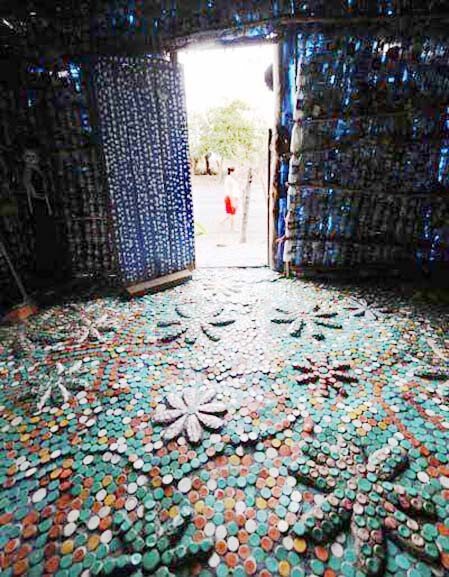
This house was built from empty plastic bottles by Maria Ponce, 76, who lives in the village of El Borbollon, El Salvador. Maria built this house in 2003 with plastic bottles because she did not have enough money to make it in the usual way. Below, Maria stands inside of her home, showing off the roof, which is also built from plastic bottles.
Eighty-six-year-old Maria Ponce, stands at the door of her house in the village of El Borbollon, El Transito, west of San Salvador, on March 14, 2017.
Campo Cielo is a sort of club room for women realized in Tegucigalpa, Honduras, 2004 by Andreas Froese. It offers shelter for about eight people. The building has an integrated water tank which required that cement had to be used in order to protect the earth mortar from water.
Froese usually does not apply cement in the walls of the buildings, but rather relies on earth mortar to stick the PET bottles together (see for example also the Trivadrum Cerala in India on this page).
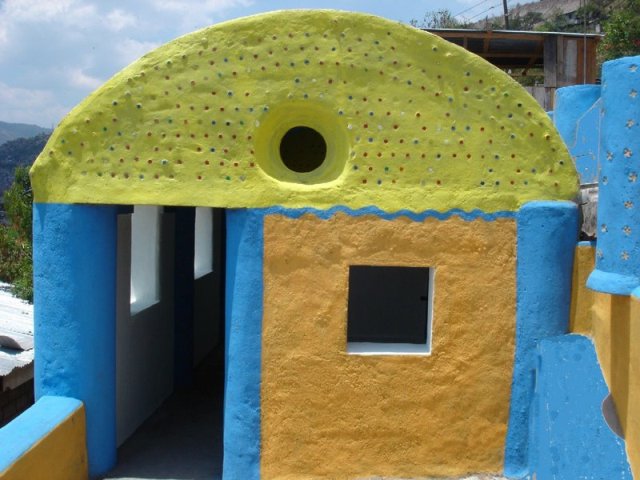
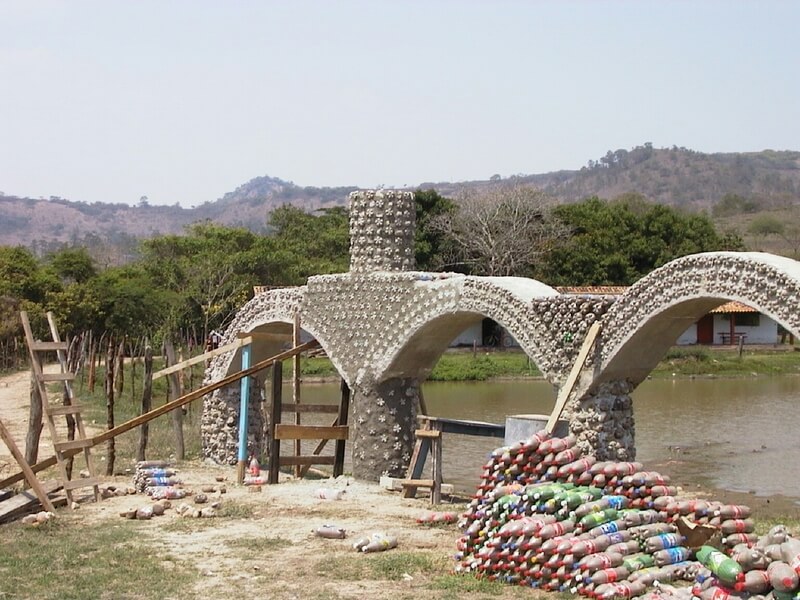
In order to experiment with vault structures incorporating PET bottles, the study object Aquaducto Romano was built by the Foundation Ecopark Zamorano in Honduras (2004). A copy of a Roman aquaduct, multiple methods of building and more than ten different mixtures of mortar (mixtures of cement, earth, and lime) are tested in this object.
Froeses’ work has found a lot of application all over the world, and can be found from Honduras and Mexico to Nigeria, India, and other countries.
missing text
Nigeria
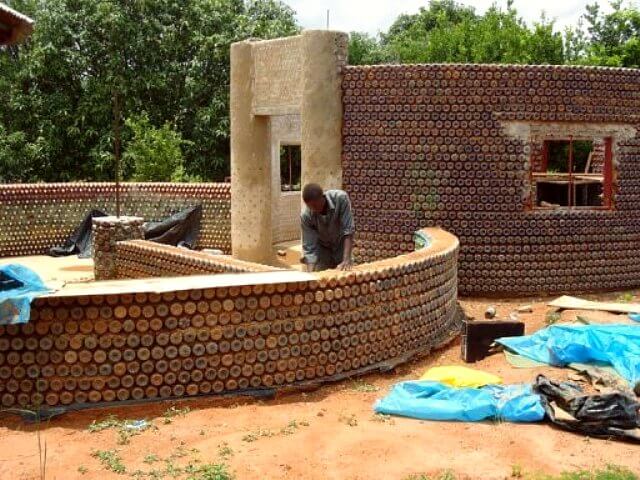
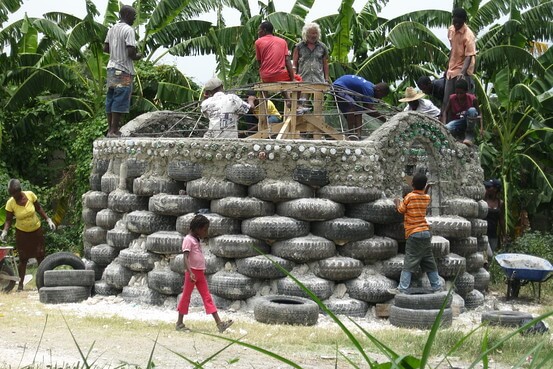
After we finish up our prototype demonstration Earthship at the Grassroots compound in late January, 2011, we are taking what we learned from that and what we have absorbed from our time spent with the Haitian people and attempting to move forward with project H.E.L.P. – Haiti Eco Living Project. Groups of Earthships the Haitian people can build themselves that are absolutely sustainable. These Earthships are built using materials found in and around Port-Au-Prince.
Veronika Richterová is a Czech PET bottle artist having generated thousands of art objects from this material. Additionally, she has collected PET bottles from all over the world to showcase them in a museum of PET bottles.
The artist is presenting a possible use of PET bottles in theatre architecture or public installations. For transforming the material she employs hot air gun and regular carpentry tools. Attachment points are purely mechanical and the sculptures can be recycled after demounting.
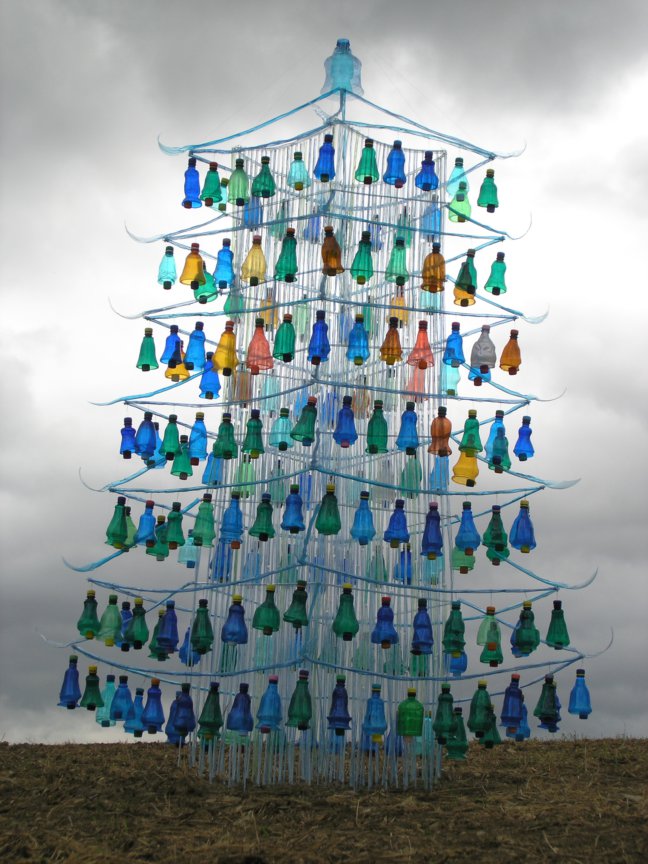
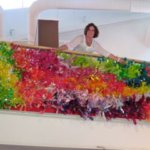
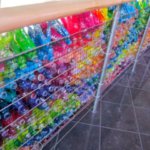
Dale Wayne works with groups and individuals across the country, transforming recycled plastic bottles to create her installation Dancing on Joy’s Horizon: Bridging Communities. Participants cut and paint recycled plastic bottles, transforming them into glasslike sparkling blossoms and ribbons. Ms. Wayne then attaches their contributions to panels to be installed onto the fence that wraps the Kent County Courthouse during ArtPrize 2014.
Legge Lewis Legge Cup City was a temporary interactive art installation comprised of a 2000- square-foot structure built using rented chain link fence panels at the Austin City Limits Music Festival, September 23–25, 2005, in Austin, Texas. Over the course of three days, concertgoers filled the structure with approximately 25,000 recycled cups and bottles. Budget $5000 Commissioned by and presented in collaboration with Austin Green Art. The walls of the lounge were slowly filled with disposable containers by concert-goers and volunteers, many of whom spent hours arranging and rearranging patterns in the chain link panel walls. Cup City engaged and displayed a portion of the Festival crowds’ stream of consumption, diverting approximately 25,000 used bottles, cups and cans into its ever-changing web.
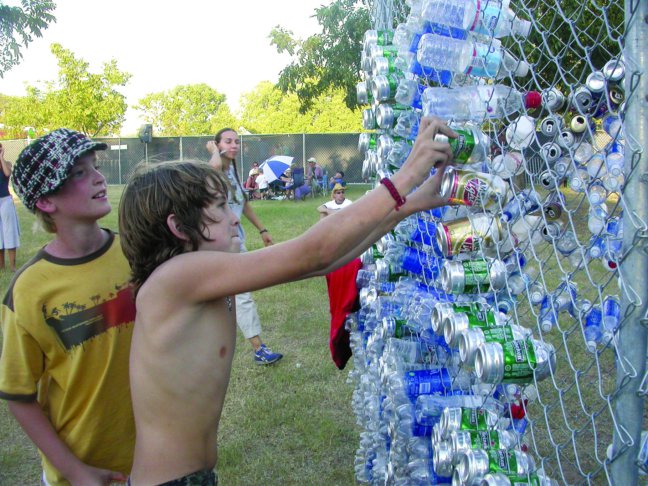
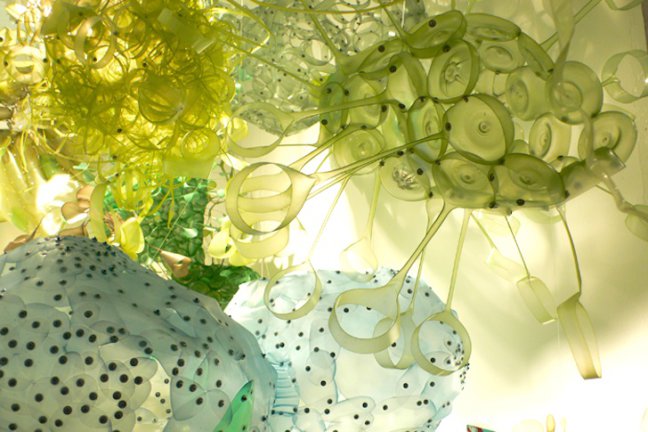
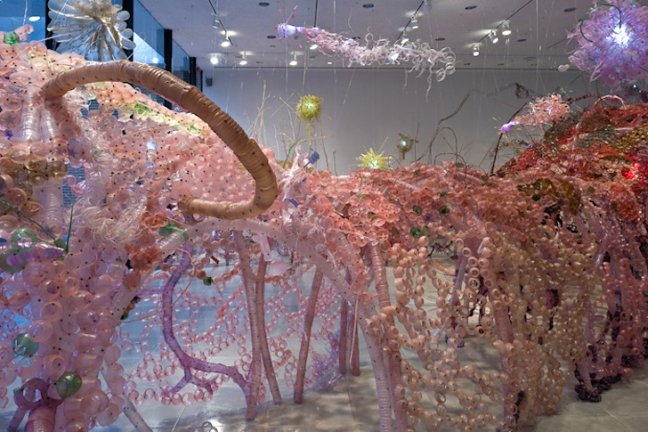
Ethereal Plastic Art 2008
Aurora Robson is a Canadian artist who has been working with garbage for over 10 years. During this time around 80 000 PET bottles went through her hands and easily 100 000 caps. In The Great Indoors instalation she had collected 15 000 PET bottles to assemble an exotic looking tunnel in a gallery. Not only she had collected the bottles on her own, but she also engages homeless and poor people in the collecting of bottles.
Currently, she is not only organising a collective of artists working with plastic debris called Project Vortex but she is also teaching a course on how to work with garbage.
ECO Project with students of the Experimental studio Achten/Nováková at FA CTU Prague2014. Relax square was showing one minute production of PET bottles. It took only few hours to assemble.
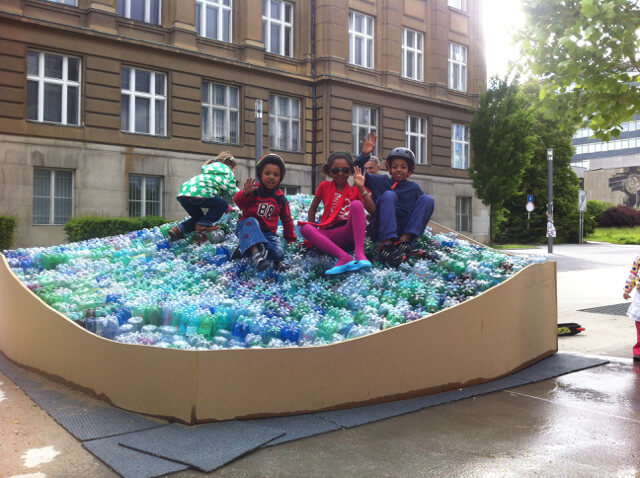
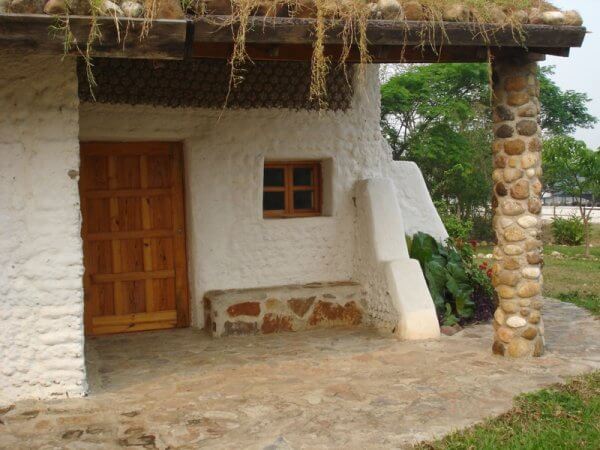
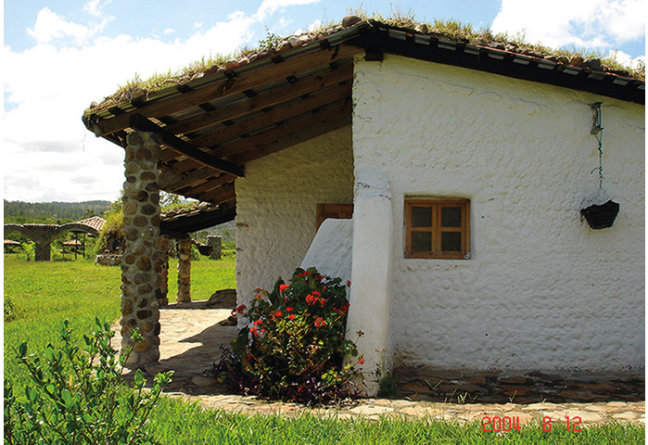
Andreas Froese is a German active in Honduras, South America and who has developed a number of techniques to integrate PET bottles in building construction. For this purpose he started the company ECO-TEC in 2001 in Honduras. This company supports among other environmental issues the reuse of solid waste in architecture. Froeses’ developed building technique reduces the use of concrete in building to 40% of regular cost. The system uses the PET bottle as a brick, fills it with natural resources such as sand or mud, and sticks it clay and other locally produced garbage such as rubble and vermiculture. Froese usually employs people in social need which adds another dimension of sustainability to his approach.
In El Zamorano, Honduras, a house from 8000 PET bottles was constructed in 2003. The green roof in wet conditions can weigh up to 30 tons. Nevertheless, there are no extra reinforced supports other than the PET wall. This house is generally considered the first PET bottle house without the use of cement for the walls.
La Casa Botellas in Puerto Iguazu in Argentina is the work of Alfredo Santa Cruz, who is neither architect nor engineer. Initially he built a play-house for his daughter from recycled materials and found the result so fascinating that he decided to continue. He built a residence for his family much in the same spirit as Andreas Froese discusses earlier in this book: to solve the garbage problem in combination with housing shortage. Within the wooden frame he placed about 1200 PET bottles as filling; he made curtains out of the bottle caps, and the roof contains 1300 re-used tetrapackages.

